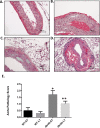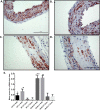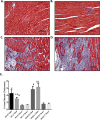Cardiovascular manifestations of renovascular hypertension in diabetic mice
- PMID: 26925344
- PMCID: PMC4768709
- DOI: 10.7717/peerj.1736
Cardiovascular manifestations of renovascular hypertension in diabetic mice
Abstract
Purpose. Type 2 diabetes is the leading cause of end stage renal disease in the United States. Atherosclerotic renal artery stenosis is commonly observed in diabetic patients and impacts the rate of renal and cardiovascular disease progression. We sought to test the hypothesis that renovascular hypertension, induced by unilateral renal artery stenosis, exacerbates cardiac remodeling in leptin-deficient (db/db) mice, which serves as a model of human type II diabetes. Methods. We employed a murine model of renovascular hypertension through placement of a polytetrafluoroethylene cuff on the right renal artery in db/db mice. We studied 109 wild-type (non-diabetic, WT) and 95 db/db mice subjected to renal artery stenosis (RAS) or sham surgery studied at 1, 2, 4, and 6+ weeks following surgery. Cardiac remodeling was assessed by quantitative analysis of the percent of myocardial surface area occupied by interstitial fibrosis tissue, as delineated by trichrome stained slides. Aortic pathology was assessed by histologic sampling of grossly apparent structural abnormalities or by section of ascending aorta of vessels without apparent abnormalities. Results. We noted an increased mortality in db/db mice subjected to RAS. The mortality rate of db/db RAS mice was about 23.5%, whereas the mortality rate of WT RAS mice was only 1.5%. Over 60% of mortality in the db/db mice occurred in the first two weeks following RAS surgery. Necropsy showed massive intrathoracic hemorrhage associated with aortic dissection, predominantly in the ascending aorta and proximal descending aorta. Aortas from db/db RAS mice showed more smooth muscle dropout, loss of alpha smooth muscle actin expression, medial disruption, and hemorrhage than aortas from WT mice with RAS. Cardiac tissue from db/db RAS mice had more fibrosis than did cardiac tissue from WT RAS mice. Conclusions. db/db mice subjected to RAS are prone to develop fatal aortic dissection, which is not observed in WT mice with RAS. The db/db RAS model provides the basis for future studies directed towards defining basic mechanisms underlying the interaction of hypertension and diabetes on the development of aortic lesions.
Keywords: Cardiovascular disease; Diabetes; Hypertension; Renal artery stenosis.
Conflict of interest statement
The authors declare there are no competing interests.
Figures





Similar articles
-
Combined effect of hyperfiltration and renin angiotensin system activation on development of chronic kidney disease in diabetic db/db mice.BMC Nephrol. 2014 Apr 4;15:58. doi: 10.1186/1471-2369-15-58. BMC Nephrol. 2014. PMID: 24708836 Free PMC article.
-
Cardiovascular phenotype in Smad3 deficient mice with renovascular hypertension.PLoS One. 2017 Oct 26;12(10):e0187062. doi: 10.1371/journal.pone.0187062. eCollection 2017. PLoS One. 2017. PMID: 29073282 Free PMC article.
-
Smad3 Signaling Promotes Fibrosis While Preserving Cardiac and Aortic Geometry in Obese Diabetic Mice.Circ Heart Fail. 2015 Jul;8(4):788-98. doi: 10.1161/CIRCHEARTFAILURE.114.001963. Epub 2015 May 18. Circ Heart Fail. 2015. PMID: 25985794 Free PMC article.
-
An Outline of Renal Artery Stenosis Pathophysiology-A Narrative Review.Life (Basel). 2021 Mar 7;11(3):208. doi: 10.3390/life11030208. Life (Basel). 2021. PMID: 33799957 Free PMC article. Review.
-
Management of renal artery stenosis: What does the experimental evidence tell us?World J Cardiol. 2014 Aug 26;6(8):855-60. doi: 10.4330/wjc.v6.i8.855. World J Cardiol. 2014. PMID: 25228964 Free PMC article. Review.
Cited by
-
Kill two birds with one stone: making multi-transgenic pre-diabetes mouse models through insulin resistance and pancreatic apoptosis pathogenesis.PeerJ. 2018 Apr 17;6:e4542. doi: 10.7717/peerj.4542. eCollection 2018. PeerJ. 2018. PMID: 29682407 Free PMC article.
References
-
- Biernacka A, Cavalera M, Wang J, Russo I, Shinde A, Kong P, Gonzalez-Quesada C, Rai V, Dobaczewski M, Lee D-WW, Wang X-F, Frangogiannis NG. Smad3 signaling promotes fibrosis while preserving cardiac and aortic geometry in obese diabetic mice. Circulation Heart failure. 2015;8(4):788–798. doi: 10.1161/CIRCHEARTFAILURE.114.001963. - DOI - PMC - PubMed
-
- Cheng JF, Grande JP. Transforming growth factor-beta signal transduction and progressive renal disease. Experimental Biology & Medicine. 2002;227(11):943–956. - PubMed
Grants and funding
LinkOut - more resources
Full Text Sources
Other Literature Sources
Miscellaneous

